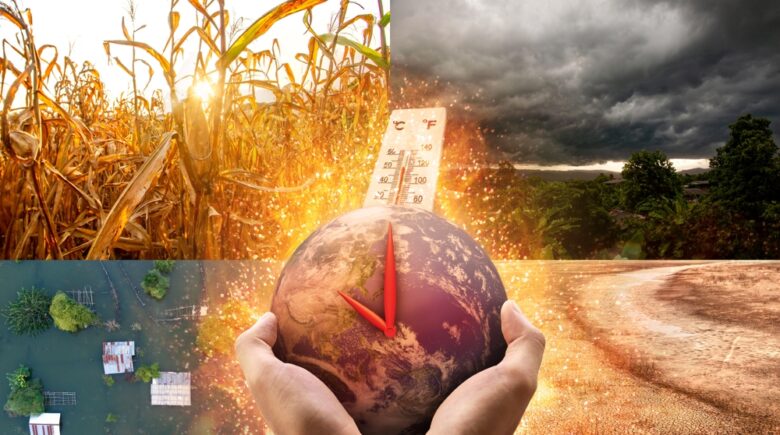How Climate Change Is Fueling Extreme Weather and What We Must Do Now to Protect Lives, Economies, and Our Future
2024 Wasn’t Just Hot — It Was a Global Wake-Up Call
You felt it, didn’t you? That eerie stillness before a heatwave rolls in like a furnace. The déjà vu of yet another “once-in-a-century” storm. Climate change isn’t knocking politely anymore—it’s stormed through the front door, bringing with it a cascade of extreme weather events that feel more like dystopian fiction than reality.
In 2024, the planet didn’t just warm—it roared. Global temperatures surged past the critical 1.5°C threshold, long considered the danger zone. This wasn’t a one-off anomaly. Every major climate agency—from NASA to the EU’s Copernicus—confirmed it: this was a boiling point.
Breaking Records, Breaking Systems
The Earth’s temperature rose between 1.47°C and 1.62°C above pre-industrial levels. That might sound like a small change, but in climate terms, fractions matter. They determine whether crops survive or die, whether storms are disruptive or catastrophic. The difference between manageable and devastating.
The 1.5°C target wasn’t chosen at random. It’s the product of years of research, debate, and consensus—etched into the Paris Agreement as a vital guardrail. And yet, in 2024, we blew past it. Yes, climate targets focus on decades, not individual years—but this year lit a flare in the sky. A warning: we’re no longer approaching the edge. We’re already there.
Extreme Weather, Amplified
The changes aren’t subtle—they’re overwhelming. The IPCC, typically cautious in its language, now confirms that the link between global warming and extreme weather is no longer up for debate.
Jet streams are weakening. Rainfall patterns are becoming erratic. Heatwaves are no longer rare—they’re routine. Droughts are spreading, swallowing once-productive farmland. And when the rain finally comes, it often arrives in devastating torrents, flooding cities and overwhelming infrastructure.
Storm systems—hurricanes, typhoons, cyclones—are intensifying. Fueled by warmer oceans, they now bring destruction on a scale that’s difficult to grasp: roofs ripped off, entire communities submerged, millions displaced. Disasters no longer happen one at a time—they arrive in sequences: a heatwave followed by wildfires, a drought followed by floods. Each event worsens the next.
What’s Driving the Chaos?
Think of the atmosphere as a sponge: the warmer it gets, the more moisture it holds. For every 1°C rise in temperature, the air can absorb about 7% more water. When that sponge is squeezed, it dumps massive amounts of rain. At the same time, increased heat pulls more water from the ground, drying out soil, withering crops, and depleting reservoirs.
The result? A vicious cycle. Dry soil reflects more sunlight, making the land hotter, which dries it further. And the oceans—once climate buffers—are now feeding these weather monsters like energy drinks to a sprinter.
More heat means more energy. And more energy means more destruction.
The Human Cost Is Real—and Growing
Climate change isn’t just about weather. It’s about lives, livelihoods, and entire economies. Between 2014 and 2023, climate-related disasters caused an estimated $2 trillion in global damages. In the past two years alone: $451 billion. That’s infrastructure destroyed, harvests lost, homes obliterated.
In the United States, billion-dollar disasters are now routine. In the Global South, a single disaster can wipe out years of economic progress. And the burden falls heaviest on the most vulnerable: the poor, the elderly, children, people with disabilities. They are the first to suffer—and the last to recover.
Beyond the financial toll, there’s a growing health crisis: heatstroke in crowded cities, disease outbreaks after floods, mental health struggles in displaced communities.
So What Now? Is There a Way Back?
There’s no undo button—but there is a path forward.
We must confront the root cause: greenhouse gas emissions. Fossil fuels—coal, oil, gas—must be phased out rapidly. The transition to renewable energy isn’t a dream of the future—it’s a necessity of the present. Solar, wind, geothermal power—they’re proven, scalable, and ready.
Energy efficiency must become a top priority. We need smarter buildings, greener transportation, sustainable farming practices, and thriving natural ecosystems—forests, wetlands, and oceans—that can absorb carbon and buffer us from the worst impacts.
Even if we stopped all emissions tomorrow, the impacts would still unfold for years. That’s why adaptation is equally vital. We need early warning systems, resilient infrastructure, drought-resistant crops, and disaster-ready cities. Preparing for the future isn’t optional—it’s survival.
There Is Hope—If We Act Fast
Not all the news is grim. Brazil’s cistern program is helping families survive droughts. The Netherlands is reshaping rivers to prevent flooding. India’s heatwave action plans are saving lives every summer. Innovation is happening—we just need to scale it up.
This Is the Defining Moment
The heat of 2024 isn’t just another data point. It’s a warning, etched into scorched fields, flooded streets, and families seeking refuge. But the story isn’t over—we’re still writing it.
Governments must legislate and invest. Businesses must act swiftly and responsibly. Communities must adapt and support one another.
And individuals—you—have power. What you eat, how you travel, where you bank and invest—these choices matter. This isn’t about guilt. It’s about collective strength.
Yes, time is running out. But we still have choices. The question isn’t whether we can respond.
The question is: Will we?
Choose action. Choose justice. Choose a livable future. Because the future isn’t waiting.



